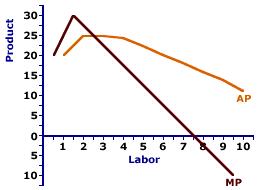
|
|
UTILITY MEASUREMENT: A quantification of the satisfaction of wants and needs achieved through the consumption of goods and services. In principle, utility measurement can take one of two forms: (1) cardinal, which is based on numerical values (1, 2, 3, etc.) and (2) ordinal which is based on rankings (first, second, third, etc.). While the hypothetical instructional analysis of utility relies on cardinal utility, ordinal utility is a more realistic way to measure satisfaction.
Visit the GLOSS*arama
|
|


|

|
                           AVERAGE PRODUCT AND MARGINAL PRODUCT: A mathematical connection between average product and marginal product stating that the change in the average product depends on a comparison between the average product and marginal product. If marginal product is less than average product, then average product declines. If marginal product is greater than average product, then average product rises. If marginal product is equal to average product, then average product does not change. The relation between average product and marginal product is one of several that reflect the general relation between a marginal and the corresponding average. The general relation is this:- If the marginal is less than the average, then the average declines.
- If the marginal is greater than the average, then the average rises.
- If the marginal is equal to the average, then the average does not change.
This general relation surfaces throughout the study of economics. It also applies to average and marginal cost, average and marginal revenue, average and marginal propensity to consume, and well, any other average and marginal encountered in economics.Making Tacos| Average and Marginal Product |  |
The graph at the right for the hourly production of Super Deluxe TexMex Gargantuan Tacos (with sour cream and jalapeno peppers) illustrates the relation between average product and marginal product.The Law of Diminishing Marginal ReturnsThis average-marginal relation for production is closely tied to the law of diminishing marginal returns. Marginal product declines with the onset of diminishing marginal returns. The "hump shape" of the marginal product curve reflects first increasing marginal returns then decreasing marginal returns.For this reason, the "hump shape" of the average product curve is attributable, indirectly, to the law of diminishing marginal returns and the "hump shape" of the marginal product curve. Increasing marginal returns means marginal product is rising and because average product necessarily starts at zero (zero production means zero average product), marginal product lies above average product and causes it to rise, as well. With the onset of decreasing marginal returns, marginal product declines. However, for this initial part of the marginal product decline, average product continues rising because marginal product is still greater. After marginal product falls enough to meet up and intersect average product, average product peaks. As marginal product, again guided by the law of diminishing marginal returns, continues to decline and falls below average product. This causes the decline of average product. In essence, the average product curve plays catch-up to the marginal product curve, sort of follow the leader. At first, marginal product rises, so average product tags along like an annoying younger sibling. Then marginal product decides to fall, so average product chases after it. Because marginal product is guided by the law of diminishing marginal returns, so too is average product.

Recommended Citation:AVERAGE PRODUCT AND MARGINAL PRODUCT, AmosWEB Encyclonomic WEB*pedia, http://www.AmosWEB.com, AmosWEB LLC, 2000-2025. [Accessed: July 18, 2025].
Check Out These Related Terms... | | | |
Or For A Little Background... | | | | | | | | | | |
And For Further Study... | | | | | | |
Search Again?
Back to the WEB*pedia
|



|

|
BLUE PLACIDOLA
[What's This?]
Today, you are likely to spend a great deal of time searching the newspaper want ads looking to buy either a wall poster commemorating the first day of winter or blue cotton balls. Be on the lookout for rusty deck screws.
Your Complete Scope
This isn't me! What am I?
|

|
|
Paper money used by the Commonwealth of Massachusetts prior to the U.S. Revolutionary War, which was issued against the dictates of Britain, was designed by patriot and silversmith, Paul Revere.
|

|
|
"A winner is someone who recognizes his God-given talents, works his tail off to develop them into skills, and uses those skills to accomplish his goals. " -- Larry Bird, basketball player
|

|
WFTU
World Federation of Trade Unions
|

|
|
Tell us what you think about AmosWEB. Like what you see? Have suggestions for improvements? Let us know. Click the User Feedback link.
User Feedback
|


|


